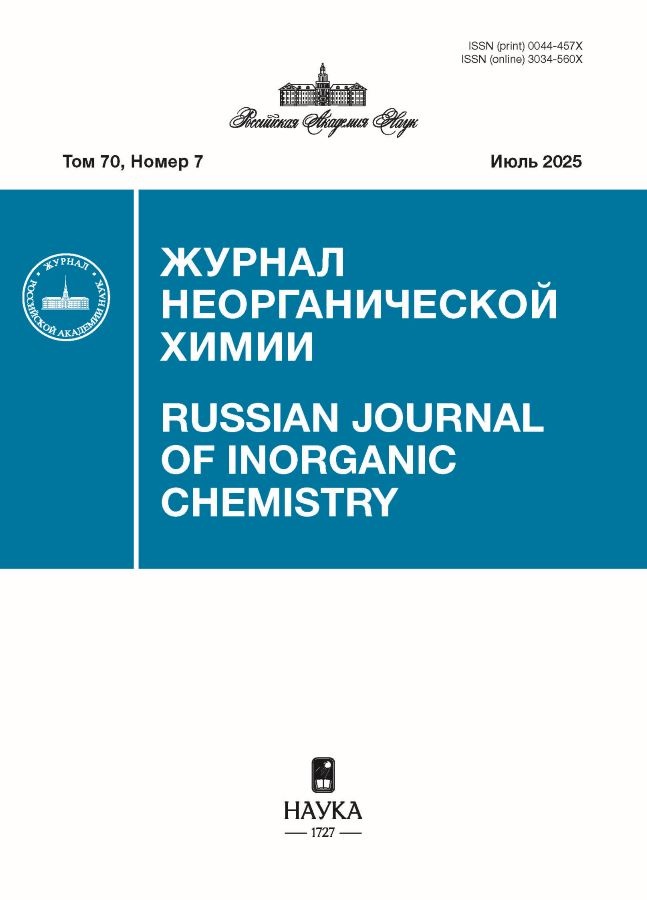Плазменно-электролитический синтез и характеристика висмутсодержащих оксидных пленок на титане
- Авторы: Попов Д.П.1,2, Васильева М.С.1,2, Курявый В.Г.2, Короченцев В.В.2, Егоркин В.С.2
-
Учреждения:
- Дальневосточный федеральный университет
- Институт химии ДВО РАН
- Выпуск: Том 70, № 3 (2025)
- Страницы: 402-410
- Раздел: НЕОРГАНИЧЕСКИЕ МАТЕРИАЛЫ И НАНОМАТЕРИАЛЫ
- URL: https://j-morphology.com/0044-457X/article/view/684989
- DOI: https://doi.org/10.31857/S0044457X25030121
- EDN: https://elibrary.ru/BAVFIB
- ID: 684989
Цитировать
Полный текст
Аннотация
Одностадийным методом плазменно-электролитического оксидирования (ПЭО) в импульсном режиме в электролите с дисперсными частицами, включающими в состав металлический висмут, сформированы висмутсодержащие пленки на титане. Морфология поверхности и состав полученных пленок изучены методами сканирующей электронной микроскопии, рентгенофазового и энергодисперсионного анализов и рентгеноэлектронной спектроскопии. Модифицирование висмутом Ti/TiO2 пленок приводит к появлению анодных фототоков в видимой области спектра, сдвигу потенциалов плоских зон в катодную область и увеличению концентрации носителей зарядов. Показано, что на характеристики и свойства полученных пленочных композитов заметное влияние оказывает длительность импульса t (0.02 или 0.05 с). При t = 0.02 с на поверхности оксидных пленок образуются агломераты частиц диаметром от 0.2 до 1 мкм с повышенным содержанием висмута. Такие пленочные композиты имеют низкую ширину запрещенной зоны, равную 1.62 эВ, и проявляют наиболее высокую фотоэлектрохимическую активность под действием видимого света.
Полный текст
Об авторах
Д. П. Попов
Дальневосточный федеральный университет; Институт химии ДВО РАН
Email: vasileva.ms@dvfu.ru
Россия, Владивосток; Владивосток
М. С. Васильева
Дальневосточный федеральный университет; Институт химии ДВО РАН
Автор, ответственный за переписку.
Email: vasileva.ms@dvfu.ru
Россия, Владивосток; Владивосток
В. Г. Курявый
Институт химии ДВО РАН
Email: vasileva.ms@dvfu.ru
Россия, Владивосток
В. В. Короченцев
Институт химии ДВО РАН
Email: vasileva.ms@dvfu.ru
Россия, Владивосток
В. С. Егоркин
Институт химии ДВО РАН
Email: vasileva.ms@dvfu.ru
Россия, Владивосток
Список литературы
- Cheng G., Liu X., Xiong J. // Chem. Eng. J. 2024. P. 157491. https://doi.org/10.1016/j.cej.2024.157491
- Bopape D.A., Ntsendwana B., Mabasa F.D. // Heliyon. 2024. V. 10. P. E39316. https://doi.org/10.1016/j.heliyon.2024.e39316
- Ali T., Ahmed A., Alam U. et al. // Mater. Chem. Phys. 2018. V. 212. P. 325. https://doi.org/10.1016/j.matchemphys.2018.03.052
- Maeda K., Domen K. // J. Phys. Chem. Lett. 2010. V. 1 P. 2655. https://doi.org/10.1021/jz1007966
- Barbosa M.O., Moreira N.F.F., Ribeiro A.R. et al. // Water Res. 2016. V. 94. P. 257. https://doi.org/10.1016/j.watres.2016.02.047
- Fujishima A., Rao T.N., Tryk D.A. // J. Photochem. Photobiol. C: Photochem. Rev. 2000. V. 1. P. 1. https://doi.org/10.1016/S1389-5567(00)00002-2
- Liu Z., Wang Q., Tan X. et al. // Alloys Compd. 2020. V. 815. P. 152478. https://doi.org/10.1016/j.jallcom.2019.152478
- Chen Y., Chen D., Chen J. et al. // Alloys Compd. 2015. V. 651. P. 114. https://doi.org/10.1016/j.jallcom.2015.08.119
- Pellegrino G., Mineo G., Strano V. et al. // Colloids Surf. A: Physicochem. Eng. Asp. 2025. V. 705. P. 135738. https://doi.org/10.1016/j.colsurfa.2024.135738
- Borilo L.P., Mal’chik A.G., Kuznetsova S.A. et al. // Russ. J. Inorg. Chem. 2014. V. 59. P. 1065. https://doi.org/10.1134/S0036023614100039
- Ilsatoham M.I., Alkian I., Azzahra G. et al. // Results Eng. 2023. V. 17. P. N100991. https://doi.org/10.1016/j.rineng.2023.100991.
- Cai N., Mai Y., Su R. et al. // Mater. Lett. 2024. V. 365. P. 136464. https://doi.org/10.1016/j.matlet.2024.136464
- Alizad S., Fattah-alhosseini A., Karbasi M. et al. // Ceram. Int. 2024. V. 50. № 22. P. 45083. https://doi.org/10.1016/j.ceramint.2024.08.347
- Vasilyeva M.S., Lukiyanchuk I.V., Budnikova Yu.B. et al. // ChemPhysMater. 2024. V. 3. № 3. P. 293. https://doi.org/10.1016/j.chphma.2024.03.003
- Vasilyeva M.S, Lukiyanchuk I.V., Sergeev A.A. et al. // Surf. Coat. Technol. 2021. V. 424. P. 127640. https://doi.org/10.1016/j.surfcoat.2021.127640
- Rogov A.B. // Mater. Chem. Phys. 2015. V. 167 P. 136. https://doi.org/10.1016/j.matchemphys.2015.10.020
- Rogov A.B., Terleeva O.P., Mironov I.V. et al. // Appl. Surf. Sci. 2012. V. 258. P. 2761. https://doi.org/10.1016/j.apsusc.2011.10.128
- Amsheeva A.A. // J. Anal. Chem. 1978. V. 33. № 6. P. 814. WOS:A1978GF08000003
- Moulder F., Stickle W.F., Sobol P.E. et al. Handbook of X-ray Photoelectron Spectroscopy, Eden Prairie: Physical Electronics, USA, 1995. 262 p.
- Salmanzadeh-Jamadi Z., Habibi-Yangjeh A., Khataee A. // J. Ind. Eng. Chem. 2024. V. 143. P. 354. https://doi.org/10.1016/j.jiec.2024.08.037
- Liang Y.-C., You S.-Y., Chen B.-Y. // Int. J. Mol. Sci. 2022. V 23. P. 12024. https://doi.org/10.3390/ijms231912024
- He Y., Cai J., Zhang L. et al. // Ind. Eng. Chem. Res. 2014. V. 53. № 14. P. 5905. https://doi.org/10.1021/ie4043856
- Muñoz A.G. // Electrochim. Acta. 2007. V. 52. № 12. P. 4167. https://doi.org/10.1016/j.electacta.2006.11.035
- Tsui L., Homma T., Zangari G. // J. Phys. Chem. C. 2013. V. 117. № 14. P. 6979. https://doi.org/10.1021/jp400318n
- Schneider M., Schroth S., Schilm J. et al. // Electrochim. Acta. 2009. V. 54. № 9. P. 2663. https://doi.org/10.1016/j.electacta.2008.11.003
Дополнительные файлы

















